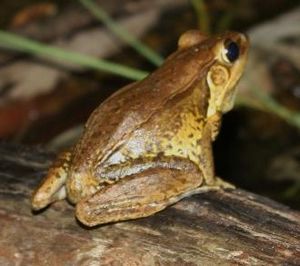Günther's frog facts for kids
Quick facts for kids Günther's frog |
|
|---|---|
 |
|
| Conservation status | |
| Scientific classification | |
| Synonyms | |
|
The Gunther's Amoy frog (Sylvirana guentheri) is a type of frog that lives in Vietnam, China, and Taiwan. It is also known by other names like Guenther's frog or Gunther's brown frog. People have even brought this frog to Guam. This amazing frog can live in places as high as 1100 meters (about 3,600 feet) above sea level.
Contents
Appearance and Size
The Gunther's Amoy frog has a unique look. Adult male frogs are usually about 6.3 to 6.8 centimeters (2.5 to 2.7 inches) long. Female frogs are a bit bigger, measuring around 7.5 to 7.6 centimeters (about 3 inches) long.
This frog has very long back legs, which are about one and a half times longer than its body. It has special teeth called vomerine teeth and a large tongue. You can also spot a fold of skin on each side of its body. This fold runs all the way from its eye down to its hip. The frog's back is usually brown or yellow-brown, while its belly is white.
Life Cycle
The female Gunther's Amoy frog lays her eggs in rice fields and streams. She chooses places where the water does not move too quickly.
When the eggs hatch, tiny tadpoles emerge. These tadpoles are silver-white in color. They have cool stripes that go from their noses to their eyes. Each tadpole also has a dark spot right behind its eye.
Special Skin Chemicals
This frog is quite special because it makes different chemicals on its skin. One of these chemicals is called (Val1)-bradykinin. The frog uses this chemical to help protect itself. It can stop larger animals from wanting to eat it.
The frog's skin also produces natural antibiotics. These include chemicals like guentherin, brevinin-2GHa, brevinin-2GHb, brevinin-2GHc, and temporin-GH. These antibiotics help the frog stay healthy and fight off germs.
Important Safety Information
Sometimes, a tiny parasite called Angiostrongylus cantonensis can live inside this frog. This parasite is also known as the rat lungworm. If humans accidentally come into contact with this parasite, it can cause a sickness called angiostrongyliasis. This illness can make people very sick and cause problems with the membranes around the brain. It's important to be careful and always wash your hands after touching any wild animals.
See also
 In Spanish: Sylvirana guentheri para niños
In Spanish: Sylvirana guentheri para niños


